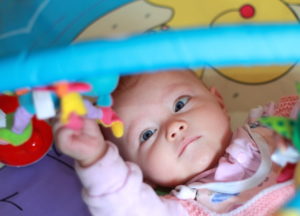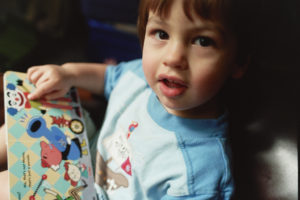As a child develops, so does their sensory system, allowing them to react to the world and the people in it. Most children are able to comprehend sight, sound, touch, taste, and smell and process them in a way that works seamlessly together. Some children, though, experience problems with sensory integration and have adverse effects to the same sensory signals.

For infants experiencing delays in sensory integration, everything that goes on around them is amplified and can make them uncomfortable. Sounds can be overwhelming and touch can put them in a panic. At times, it makes it difficult for the infant or child to function well.
Problems with a premature sensory system are often caused by how the brain and nervous system work together, and every child is wired differently. Sensory issues most often show up in children that were born prematurely, but they can be seen in full-term infants, as well as children that have been diagnosed with autism, attention deficit disorders, processing disorders, Down Syndrome, anxiety, and depression.
Symptoms of Delay In Sensory Integration In Children
If your child is experiencing a delay in sensory integration, you may notice some of the following symptoms or behaviors:
 Sensitivity to touch: They are bothered by the slightest touch, don’t enjoy being held or being near others.
Sensitivity to touch: They are bothered by the slightest touch, don’t enjoy being held or being near others.- Sensitivity to sound: Noises bother them even if it is a background noise that is not readily apparent.
- Clothing sensitivity: Tags or certain fabrics are intolerable.
- Moves excessively: Bounces, jumps, swings or moves excessively in a nervous or uncomfortable way.
- Avoids child-friendly foods: Dislikes foods that most children gravitate towards, or only likes crunchy soft foods, or foods that are tan/neutral-colored.
- Poor attention: Cannot focus on activities/play. May tune out or act up as a response mechanism.
Symptoms of Delay in Sensory Integration in Infants
Babies also experience sensory overload and can also have sensory integration issues. As a parent, it’s important to learn to recognize the signs that your baby is being overwhelmed and stressed. Knowing these cues can help reduce the strain on your baby’s premature sensory systems when they are being overloaded.
A baby will often display these behaviors when their sensory system is being overworked/stressed and they are uncomfortable with the situation at hand:
- Increased heart rate
- Increased breathing rate
- Changes in skin color
- Onset of hiccups or yawning
- Arching of the back
- Fussing and crying
- Sneezing
- A complete shutdown
How to Reduce Sensory Overload With Your Infant
As a parent you want to do everything you can to calm your baby when they are in distress. When your baby has a premature sensory system, it may seem that no matter what you do, you are making the situation worse. Your baby isn’t able to tell you what is wrong so you must respond by doing everything you can to reduce the stimulation around them.
Some ways you can help eliminate the stress that they are feeling from over stimulation can include:
Firm touch: While you may feel the natural ability to gently calm you baby by holding them lightly when in actuality, they need a firm touch to feel secure. Try holding them with your full hand and using a swaddling to make them feel protected. This can work to calm them and make them relax. You can also try
Smell: Your baby may respond to your personal smell as a way to calm their senses. They may feel reassured by the smells of their mother and feel secure when clothing smells like you is nearby. Avoid excessive smells from perfume, deodorant or shampoo as this can cause your baby’s premature sensory system to overload and they will become agitated or upset.
Sound: Any noise can set your baby off and make them feel stressed. Even a simple noise as the running of appliances can affect how your baby feels and reacts. Try using noise dampening materials in the room where they sleep to reduce some of the background noises that are affecting them. When your baby becomes distressed due to noises, reduce them as best you can to give your baby relief.
Sight: Reduce as much the light stimulation as you can. Try dimming the lights and turning off background lights from the televisions so your child is able to fall asleep. A healthy sleep pattern can improve the sensory integration in babies, allowing them to be more comfortable around stimuli. It is also a good idea to visually mute the room of your baby by removing any objects or decorations that would cause over stimulation.
Feeding: As you feed your baby, it is important to allow them to focus on that task. They may find that your talking, singing or movement distracting. Allow them to eat in quiet and resume interacting with them once they have completed feeding as this will give them the opportunity to develop their premature sensory system.
Temperature: Keeping your baby comfortable can also make them feel at ease. Be sure to keep your home between 68 and 74 degrees for optimal warm and dress your baby in layers to protect them from drafts. Keep them away from fans. Swaddling is a good option until they start rolling over. Then swaddle underneath the armpits during sleep so their hands are free to help with movement.
As your baby or child develops a premature sensory system, you can help them overcome some of the issues associated with sensory overload by limiting the amount of stimulation they come in contact with.
References:
Graven, N.S. & Browne, J.V. (2008). Sensory development in the fetus, neonate, and infant. Introduction and overview. Newborn and Infant Nursing Reviews, 8, 169-172.
Kinnealley, M. (1990). Some do’s and don’t’s with hypersensitive babies. Intensive Caring Unlimited. March/April.
About Tracey Kondrasuk-Brander

Tracey Kondrasuk-Brander works part-time as a NICU Occupational Therapist at Wellspan Health. She is also a Licensed Massage Therapist and Early Intervention Occupational Therapist. Tracey has recently launched a new on-line consulting website, Early Developmental Therapy Consultants, to help parents of premature infants with questions about developmental concerns and occupational therapy.
